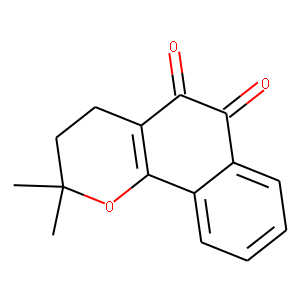| Reference | 1. Curr Cancer Drug Targets. 2002 Sep;2(3):227-42.
<br><br>
Cancer therapy with beta-lapachone.
<br><br>
Pardee AB(1), Li YZ, Li CJ.
<br>
Author information: <br>
(1)Dana-Farber Cancer Institute, 44 Binney Street, Boston, MA 02115, USA.
[email protected]
<br>
Beta-lapachone is an ortho naphthoquinone, originally isolated from a tree whose
extract has been used medicinally for centuries. Recent investigations suggest
its potential application against numerous diseases. Its lethality at micromolar
( m) concentrations against a variety of cancer cells in culture indicates its
potential against tumor growth. A few experiments with positive results have been
performed that apply the compound to tumors growing in animals. Particularly
promising is the remarkably powerful synergistic lethality between beta-lapachone
and taxol against several tumor cell lines implanted into mice; the mice did not
appear to be adversely affected. Enhanced lethality of X-rays and alkylating
agents to tumor cells in culture was reported when beta-lapachone was applied
during the recovery period, because of inhibition of DNA lesion repair. Clinical
trials are still to be initiated. The detailed mechanism of cell death induced by
beta-lapachone remains for investigation. DNA topoisomerase I was the first
biochemical target of beta-lapachone to be discovered, although its role in cell
death is not clear. A proposed mechanism of cell death is via activation of a
futile cycling of the drug by the cytoplasmic two-electron reductase NAD(P) H:
quinone oxidoreductase, also known as NQO1, DT-diaphorase and Xip3. Death of NQO1
expressing cells is prevented by the NQO1 inhibitor dicoumarol, and cells with
low NQO1 are resistant. At higher drug concentrations the production of reactive
oxygen species (ROS) appears to be responsible. Furthermore, this process is p53-
and caspase- independent. Either apoptotic or necrotic cell death can result, as
reported in various studies performed under differing conditions. Beta-lapachone
is one of a few novel anticancer drugs currently under active investigation, and
it shows promise for chemotherapy alone and especially in combinations.
<br><br>
2. Medicina (B Aires). 2001;61(3):343-50.
<br><br>
[Cytotoxicity of beta-lapachone, an naphthoquinone with possible therapeutic
use].
<br><br>
[Article in Spanish]
<br>
Dubin M(1), Fernandez Villamil SH, Stoppani AO.
<br>
Author information: <br>
(1)Centro de Investigaciones Bioenergéticas, Facultad de Medicina (UBA-CONICET),
Universidad de Buenos Aires.
<br>
beta-lapachone (beta-lap) is a lipophilic o-naphthoquinone isolated from the bark
of the lapacho tree. Initial observations proved its capability for inhibiting
growth of Yoshida tumor and Walker 256 carcinosarcoma. beta-Lap redox-cycling in
the presence of reductants and oxygen yields /reactive oxygen species/ (ROS: O2-,
OH and H2O2) which cytotoxicity led to assume its role in beta-lap activity in
cells. beta-Lap inhibited DNA synthesis in Trypanosoma cruzi as well as
topoisomerases I and II, poly(ADP-ribose) polymerase (PARP) in different cells.
These enzymes are essential for maintaining DNA structure. beta-Lap inhibited
growth of a large variety of tumor cells including epidermoid laringeal cancer,
prostate, colon, ovary and breast cancer and also different types of leukemia
cells. Advances in knowledge of apoptosis (/programmed cell death/) and necrosis
provided useful information for understanding the mechanism of beta-lap
cytotoxicity. Thiol-dependent proteases (Calpaine), kinases (e.g. c-JUN
NH2-terminal kinase), caspases and nucleases are involved in beta-lap
cytotoxicity. These enzymes activity, as well as ROS production by beta-lap
redox-cycling, would be essential for beta-lap cytotoxicity. Diaphorase and
NAD(P)H-quinone reductase, which catalyse beta-lap redox-cycling and ROS
production, seem to play an essential role in beta-lap activity. On these
grounds, clinical applications of beta-lap have been suggested.<br>
|

